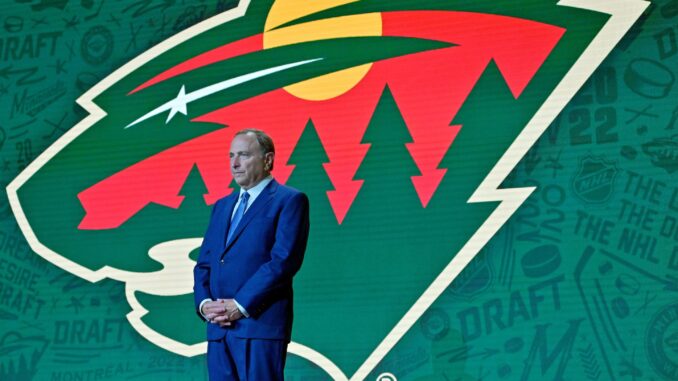
The Minnesota Wild’s decision to trade their first and third-round picks for defenseman David Jiříček makes sense after a lackluster NHL Draft with a quickly depleting talent pool. Facing a weaker draft with limited picks, Judd Brackett’s scouting team focused on securing at least one NHL-caliber player rather than chasing high-risk, high-reward talent. Historically, the Wild have mixed strategies, drafting both high-skill players like Riley Heidt and safer bets like Rasmus Kumpulainen. This year, with only five picks and low odds of landing an NHL regular (30% for second-rounders, 17% for fourth), they prioritized high-floor players. A healthy farm system needs consistent talent to avoid gaps, especially if Minnesota can’t attract top free agents. If the Wild can develop reliable depth players like Carson Soucy or Connor Dewar from this draft, alongside Jiříček, it’s a success.
So who are these guys, anyway?
52nd Overall: Theodor Hallquisth, RHD
Defenseman Hallquisth as a two-way player with strong hockey IQ, capable of reading pressure, making smart plays out of the defensive zone, and playing with competitive edge. While the Wild’s scouts valued him highly, broader scouting consensus, including Bob McKenzie’s ranking, placed him as a late second-rounder (61st overall). Typically, “two-way defenseman” suggests a defensive lean, but at 6-foot-2 and 172 pounds, Hallquisth has room to grow into a solid defensive presence. Lassi Alanen’s data from the Elite Prospects Draft Guide highlights his transition game as a strength, with controlled offensive zone entries, despite below-average puck skills per Corey Pronman. As a big, right-shot defenseman, Hallquisth is a valuable developmental prospect behind Faber, Spurgeon, Jiříček, and Spacek. His brief SHL stint with Örebro was challenging at 17, but his progress as an 18-year-old will be telling.
102nd Overall: Adam Benák, Center
Forward Benák as a dynamic offensive player with great vision, skill, speed, and tenacity despite his 5-foot-7 frame. Unlike the Wild’s typical high-floor, low-ceiling picks, Benák is a high-risk, high-reward fourth-round selection. Small stature makes NHL success rare, requiring exceptional talent like Cole Caufield or Martin St. Louis, but expecting that level is unfair, as Benák’s size likely pushed him out of earlier rounds. A better comparison is Mason Shaw, a gritty bottom-six NHLer despite injury setbacks. If Benák avoids similar injuries, he could exceed Shaw’s impact. Elite Prospects ranked him 102nd but praised his tenacity, while The Athletic’s Scott Wheeler (37th) lauded his playmaking, anticipation, skating, and competitiveness. His father’s 5-foot-10 height suggests potential growth, which could significantly boost his NHL chances, though staying at center remains unlikely.
121st Overall, Lirim Amidovski, RW
Described forward Amidovski as a high-speed, relentless forechecker with a “heat-seeking missile” style, echoed by Elite Prospects’ “missile on skates” label. Despite low-scoring OHL players rarely reaching the NHL, Elite Prospects sees Amidovski as an exception with a translatable, gritty game that could lead to an NHL role if refined. The Wild, familiar with the value of grinders after losing Duhaime, Dewar, and Shaw and acquiring Yakov Trenin, view Amidovski as a homegrown fit for that role. Mitchell Brown’s tracking highlights his net-driving ability and strong defensive metrics, suggesting sneaky upside. He could become a fan-favorite, much like Duhaime.
123rd Overall, Carter Klippenstein, Center
141st Overall, Justin Kipkie, LHD
Defenseman Kipkie, a 6-foot-3 fifth-round pick, for his puck-handling, passing, and development over recent years, noting his 33 points (draft year), 52 points, and 62 points in the WHL. Previously drafted by Arizona (now Utah Mammoth) in 2023 (160th overall), Kipkie re-entered the draft after Utah passed on him. Corey Pronman notes his average hockey sense and heavy feet but highlights his size, legit hands, and big point shot, making him a solid fifth-round gamble.
This draft class, excluding Jiříček, isn’t thrilling—none of these players will likely crack the Wild’s top-10 prospects soon, especially with stars like Jiříček, Buium, Yurov, Öhgren, and Wallstedt nearing NHL roles. With limited picks in a weak draft, the Wild targeted lower-ceiling, roster-filling players for the future. It’s a practical, if unexciting, strategy whose success will only show in time.
Source: HockeyWilderNess
Leave a Reply